St Stephen's Green’s 27 acres is the most popular park in Dublin city centre. Come for a leisurely stroll in elegant landscaped gardens, stay for the people-watching.
Although surrounded by iconic Georgian architecture, the layout of the park is quintessentially Victorian with tree-lined avenues, a duck pond, ornamental gazebos and a bandstand which is still used in summer. Statues and public artworks are found at every turn; notable ones include representations of James Joyce, Constance Markievicz, Arthur Edward Guinness, Robert Emmet and a memorial to the Great Famine. There is also a playground and a garden designed especially for people with vision impairments to enjoy.
A popular meeting spot for Dubliners, the park is busy throughout the year but on sunny days you may have to squeeze in amongst assorted groups of friends, lovers and individuals splaying themselves across the grass (the flower beds are, of course, strictly off limits).
History
Named for a medieval church and leprosy hospital, this is the site of one of Dublin’s ancient commons. Originally a sprawling 60-acre site used for grazing livestock and public executions, 23 acres was enclosed by local government in 1663 and the land around it sold off. As houses began to develop, the area became affluent and the park was a fashionable place for Dublin’s high society to stroll in and be seen.
In 1814 the green became accessible only to wealthy residents of the nearby area who could rent a key. While they carried out many improvements in the park, the move was hugely unpopular with practically everyone else. In 1877, Arthur Edward Guinness (great-grandson to the founder of Guinness) bought the park back and paid for the development which shaped the Victorian layout we see today. In 1880 it was officially returned to the public.
During the Easter Rising 1916, St Stephen’s Green was seized by the Irish Citizen Army. For the week-long conflict with the British Army, both sides agreed to a daily ceasefire so the park keeper could feed the ducks. A report from the time notes they were well fed and “very little perturbed by the bullets flying over their heads”. The choice of the park was a poor strategic one though as the British was able to commandeer the buildings surrounding it and shoot down towards the entrenchments. Bullet holes from the conflict can still be seen today at the Fusiliers’ Arch at the Grafton Street entrance.
Fusiliers’ Arch itself commemorates soldiers of the Royal Dublin Fusiliers who were killed fighting for the British in the Second Boer War and is one of the few monuments from the time of British Rule that has not been demolished.
Opening hours and other practicalities
The park is free to visit and is open all year around for daylight hours. The nearest public toilets are outside the Grafton Street entrance or inside the nearby St Stephen’s Green Shopping Centre. The Green is easily accessible by public transport; the Green Line of the Luas terminates here and most city centre buses have a stop nearby.
Hotels near St Stephen’s Green
If you want to stay in a hotel right next to St Stephen’s Green, high-end accommodation is your only option.








